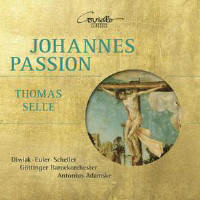Texte paru dans: / Appeared in: |
|
|
Outil de traduction |
|
|
These two Lutheran Passions from opposite ends of the Baroque spectrum show how approaches to setting the gospel accounts of Jesus’s trial and execution changed over the course of a hundred years. It would be a miracle, of course, if either reached the profundity of the Bach Passions that lie between them, but for fans of 17th- and 18th-century music they certainly make interesting listening, and have their moments.
I’ve seen the St John Passion of 1641 by Thomas Selle, Kantor at the Johanneum in Hamburg, described as ‘one of the most notable Passions of the 17th century’, and sure enough it is quite grand. Selle divides his gospel text into three sections – Peter’s denial, the trial, Jesus’s Crucifixion – and sets it mainly for solo voices and continuo representing the main characters, with specific instrumental colours attached: low viols for the Evangelist; florid violins for Christus; cornetts and trombones for Pilate. Each of these sections is followed by an expressive, polychoral motet-like ‘intermedio’ setting respectively texts from Isaiah, the Psalms and a Lutheran chorale. Simple as that. But sonically imposing and colourful though it is, and notwithstanding Selle’s thorough competence, the piece has a somewhat functional feel – a sense that decorum has prevented the drama of the Passion from penetrating very deeply into the composer’s consciousness. The work also has a damaging lack of ebb and flow, something I suspect is not entirely down to the performance, which, while offering an invigorating ensemble sound (with handsome ornaments from the instrumentalists) leaves rather long gaps between Selle’s block-like phrases. A nice rarity for Baroque enthusiasts but probably not one to set your mood for Good Friday. Two extra motets are thrown in, but the total duration is still only 52 minutes.
Bach was still performing his own Passions in Leipzig when the 28-year-old Johann Heinrich Rolle composed his St Luke Passion in 1744. A former Leipzig law student and now a member of the Berlin court music (where CPE Bach was one of his colleagues), he cannot have been unfamiliar with Bach’s models, and indeed his follows the same structural procedure in which the gospel text is conveyed in recitative by the Evangelist, Christus and other dramatic roles (crowd included). But if in these it sounds pretty much like Bach, the reflective arias, chorales and framing choruses present a very different musical language, and indeed tone. The comfortable, fluent pre-Classical manner of the galant – Bach heading towards Haydn if you like (or at least late Telemann) – may seem at first a strangely complacent vehicle for the horrors of the Crucifixion, but once you realise the subject of the arias is more that of God’s grace than identification with Christ’s suffering, the softly flickering flute triplets and stoically reassuring horns begin to seem just the thing. Even Peter’s reaction to his denial, haunted by a baleful bassoon, ends with him looking on the bright side, as does the soprano’s aria alternating troubled Sturm und Drang and Elysian calm towards the end. Whether or not this approach appeals, it should be said that Rolle’s music is of consistent quality. The choruses are robust (as in Handel’s Messiah, the crowd mocks Christ in a jabbing fugue), the arias graceful and cleverly made, and the recitatives calmly and efficiently responsive to text. Michael Alexander Willens and his musicians (who recorded Rolle’s later St Matthew Passion in 2016) give a neat and thoroughly pleasing performance. Perhaps there could have been an extra level of dramatic engagement in places – the crowd really do sound rather jolly when calling for crucifixion – but this is a well-presented premiere recording that does well by its evidently talented composer.
|
|





